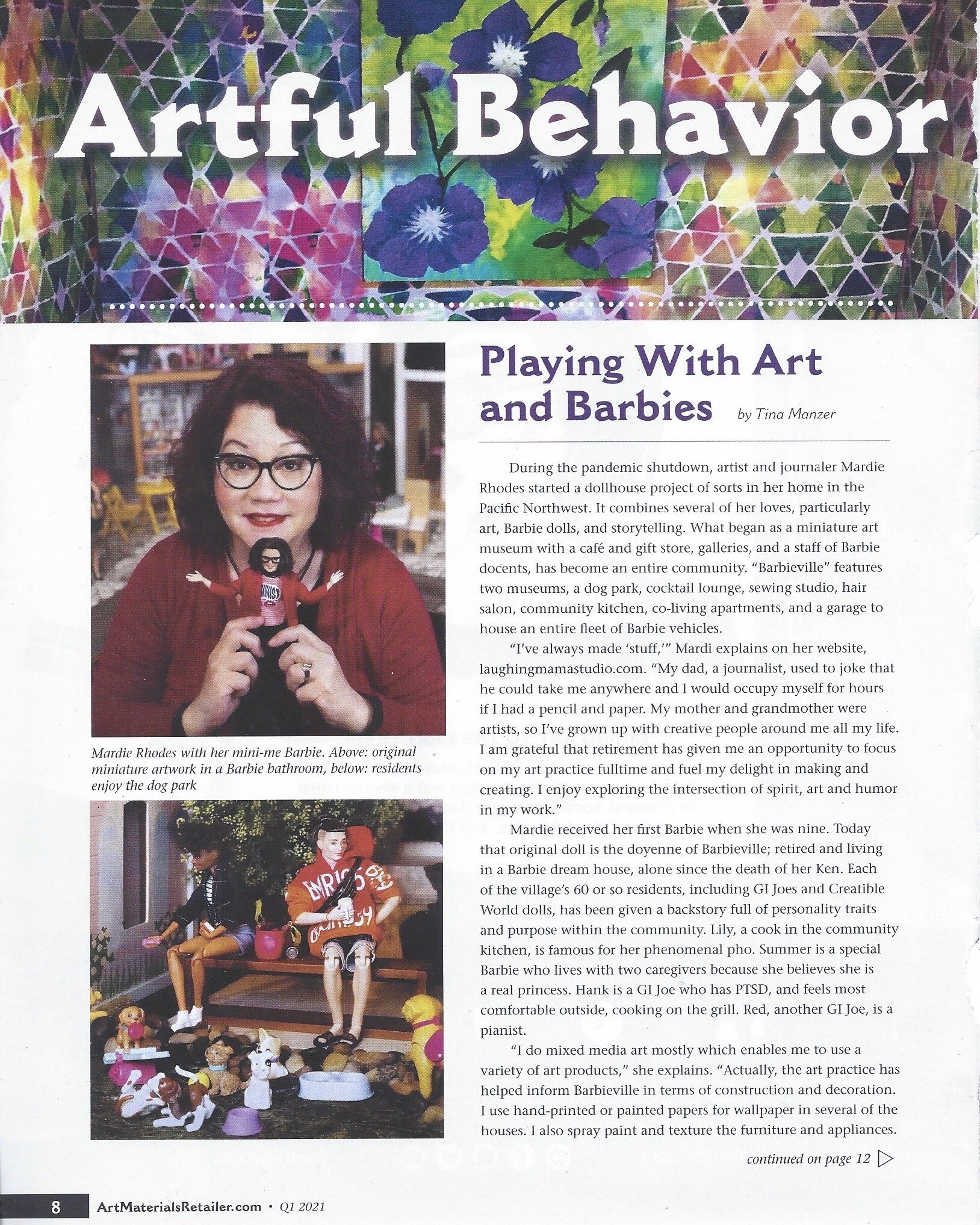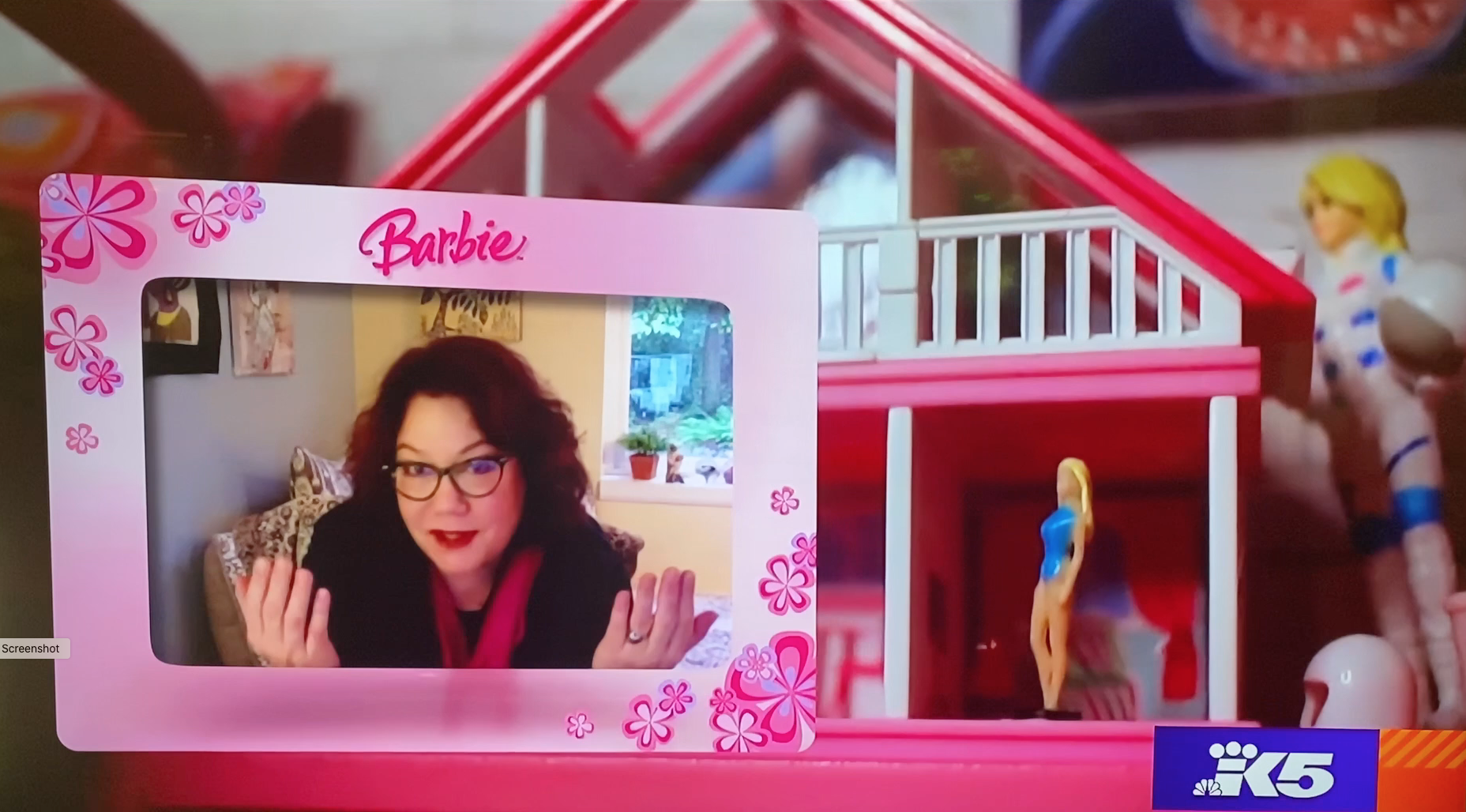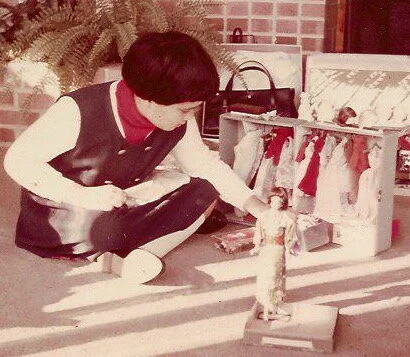My Love affair with barbie
You wouldn’t immediately figure me for a Barbie fan. I’m closer to age sixty than age six and I’m comfortable calling myself a feminist. I like sensible shoes with good support and I don’t wear a lot of pink. But I love Barbie. I love her hooker-esque wardrobe, her perfect hair, her plastic-imprinted make up, even her deformed feet. There’s no logic to it. Like so many other love affairs, I know in my heart of hearts we are not well matched, but she has been my muse for decades. I got back in touch with my love of Barbies in 2019, just before the pandemic hit. Wanna play?
KING TV “Evening Magazine” interviewed me for a story about Barbieville.
We recently did a tour of Barbieville for the docents at the Bellevue Arts Museum. Thanks to our friend, Caitlin Obom, filmmaker extraordinaire, we were able to give the docents a 20 minute tour of Barbieville. So, pull up a comfy chair with your favorite beverage (adult or otherwise) and enjoy the tour.


I have been a Barbie lover since I got my first Barbie from Aunt Lorna in 1963.
When I was seven years old my Aunt Lorna gave me my first Barbie doll and my first Barbie outfit (Evening in the Spotlight – a skintight black cocktail dress that came with a microphone and pink scarf). Who can forget the sensual titillation of that new plastic smell, her black and white striped strapless bathing suit that barely covered her breasts, her high-heeled feet? She seemed a little sexy, a little naughty. I was smitten.
Is she a dangerous icon for little girls? Does her perfect nipple-less, hairless body create unachievable expectations? Who cares? She was beautiful. She wore eyeliner and blue eyeshadow and lipstick. Best of all, she sported a blonde ponytail and peachy complexion that my mixed Asian ethnicity could only dream about. She also had an extensive wardrobe and perfectly matching accessories. When you’re a chubby part-Asian girl in South Jersey, perfect accessories and a blonde ponytail seem like ideal items for worship. Barbie the Goddess.
During significant moments in my life, she has always been there for me. Sure, she spent a decade or so wrapped in tissue paper in my mother’s sewing room closet, but she would not be ignored. Like so many women I know from the early 60’s she threw off her tissue of oppression and came out of the closet. For me her lessons are right there in black and white, or in Barbie’s case, bright pink.
Barbie’s first lesson was about money. In the 60’s Barbie clothes were exquisitely sewn with luscious fabrics and lots of detail. More than anything I wanted the Barbie wedding gown. The $5 price tag was big money in our household and it was the most expensive item in Barbie’s wardrobe. My dad mumbled that he could buy a real dress for that price; he wasn’t spending that much for a doll dress. Although my mom and grandmother could sew anything, I wanted the store-bought version. I saved my 50-cents a week allowance for what seemed forever until I had enough. I remember when my Mom drove me to Grants Department store to buy it at last. The dress had a sweetheart neckline and layers of lace over a satin underdress. It came with white shoes, a bouquet of silk flowers and a white veil with pearls that fit conveniently over her ponytail. I still have it. By age 8 Barbie had taught me the importance of economic freedom for women.
In time Barbie was packed away as I become absorbed with high school, college, marriage and all the other distractions of growing up. There wasn’t a lot of time for playing with dolls until I had children of my own. When our sons, Zak and Max came along, I learned to play with dinosaurs, plastic animals, small metal cars and plastic action figures. To my Barbie-trained eye, the action figures were attractive enough, but they had two definite shortcomings: you couldn’t change their clothes and they had no accessories (Batman was the rare exception – he carried lots of cool tools and weapons like boomerangs).
One day I was sitting on the floor inventing some game with the boys about Batman and Superman going on various adventures, when it occurred to me that Barbie could play a role. I dragged out my old Barbie dolls. The boys were fascinated. Sure, they had heard of Barbie, but she had never really crossed their paths before. Although she didn’t have a cape or any cool weapons, she could pass as a superhero once Zak fashioned a helmet for her from playdough.
Fantastic Barbie was born. It was a perfect game for two super-hero obsessed boys and their girly-girl mom. Soon Barbie was CEO of the Barbie Detective Agency and deploying the superheroes on crime-stopping adventures. By now my original Barbies and their wardrobe were supplemented with extensive yard sale finds. Barbie and her friends had quite a wardrobe. One day, as Barbie was changing into her pink satin Enchanted Evening dress with the white fur wrap, the X-Man Wolverine appeared (handled by Zak, my oldest son). When she told Wolverine about his next assignment, Wolverine stepped up and said, “I ain’t taking orders from no woman!” It was clearly a phrase Zak had picked up from television – I KNOW he never heard it at home. There was nothing else to be done. CEO Barbie fired Wolverine on the spot. As Zak sputtered, “You can’t do that!” Barbie calmly replied that she could, in fact had, done it. Wolverine was no longer in the game. Barbie taught my sons at a fairly young age that a woman claiming her own power was stronger than a superhero.
Barbie is evidence that objects are what you make them, whether flags or religious symbols or pink high heels. In fact, I still keep Corporate Barbie in my office. Purchased at a little girl’s garage sale, Corporate Barbie wears a reversible skirt (red sparkly tulle to gray tweed) a tote bag with a laptop, and of course, the all important commuter coffee mug emblazoned with the Barbie logo. She reminds me to always balance play and work, like a tweed skirt lined in sparkly tulle.
Barbie is still one of my goddesses; she speaks to me of femininity and play, not feminist repression. It makes me sad when a woman says she was too old to have her own Barbie. Barbie is now 60 and would be the last one to say you’re too old for anything. Although her career options all seem to require extensive new wardrobes, she has done it all – from police officer to astronaut to ballerina. She even rides a Harley. Both her measurements and her career path would be tough to replicate in real life, but they’re the stuff dreams are made of.
I take special joy in giving Barbies to my women friends, watching them play, remembering their girlhood and the role Barbies and dolls played or didn’t play for them. As a feminist AND a Barbie fan, I realize that women often defy our stereotypes, they are as varied and interesting and multi-faceted as, err… Barbie. It may be harder for some women to make that leap than others, but I’m out to change all that, one Barbie at a time.





